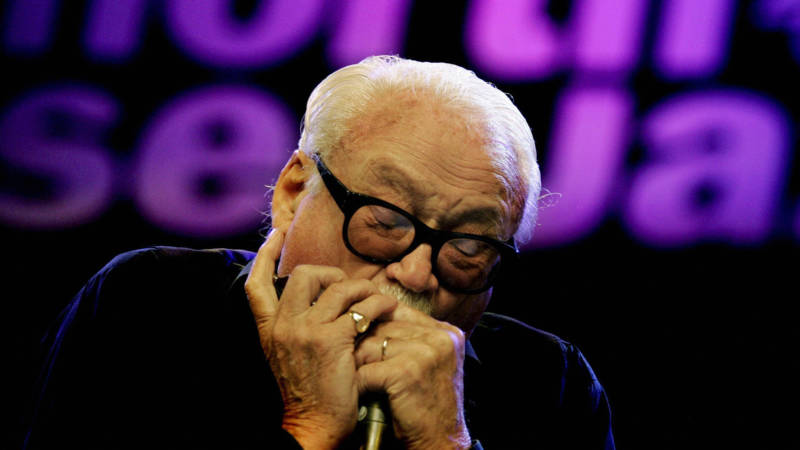Although his name wasn’t widely known outside the jazz world, many heard his harmonica playing, including generations of children who grew up with the opening theme to Sesame Street.
His harmonica was also prominently featured on movie soundtracks, including those of the Oscar-winning Midnight Cowboy, The Pawnbroker, Jean de Florette, and The Sugarland Express. Also adept as a whistler, he could be heard on the Old Spice after-shave commercials. He performed and recorded with Benny Goodman, Miles Davis, Ella Fitzgerald, Oscar Peterson, Herbie Hancock, Quincy Jones, Paul Simon and Billy Joel, among many others.
Despite suffering from asthma much of his life, Thielemans breathed artistic life into an instrument many dismiss as a toy. In the jazz world, he was the first to use the harmonica to blow complex bebop lines. He played a custom-made Hohner chromatic harmonica – different from the diatonic harmonica used by blues players – which has a slide making it possible to play three octaves in all keys.
“It’s such a freak of an instrument,” Thielemans said in a 1992 AP interview. “There’s technical obstacles to how fast and legato you can play. … What I’ve spent my time on is to try to find things that are playable on the instrument. This is not a good instrument but I blow my brains out on it.”
His zest for life was apparent in his only major hit that moved into the popular mainstream —the upbeat “Bluesette” which he first recorded in 1962, on which he showcased his signature style of whistling and playing guitar in unison.
“If there’s a piece of music that describes me, it’s that song,” he told The AP.
Thielemans was beloved in his native Belgium, not least because he always took pride in his humble background growing up in Brussels’ Marolles neighborhood.
He was ennobled by Belgium’s King Albert II with the title of baron in 2001 and received the U.S. National Endowment for the Arts Jazz Masters award in 2009, the nation’s highest jazz honor.
Belgium’s royal family said it was “deeply moved by (the) passing away of Toots Thielemans, one of the greatest jazzmen.”
“We have lost a great musician, a heartwarming personality. All my thoughts are with the family and friends of Toots Thielemans,” Belgian Prime Minister Charles Michel tweeted.
Born in Brussels on April 29, 1922, Jean-Baptiste Frederic Isidore Thielemans began playing the accordion at age 3.
He discovered jazz after the German occupation began in 1940. But after sitting in with local combos, his friends advised him to get “a real instrument.”
He taught himself to play guitar, mostly by listening to records of the legendary Belgian-born Gypsy jazz guitarist, Django Reinhardt.
When he took out his harmonica again after about two years, Thielemans said it was like discovering “an old friend.”
In 1945, as he was making a name for himself as a guitarist in local jazz clubs and dance halls, friends decided that his given name wasn’t hip enough. So he became “Toots.”
When the first bebop records by Parker and Dizzy Gillespie reached Belgium in the postwar years, Thielemans found his musical “prophets.”
In 1948, he made his first visit to the United States, and stopped off in New York on his way home. An agent heard him sitting in with Howard McGhee’s band at a local club, and a few months later, he received a letter at his Brussels home, inviting him to join Benny Goodman’s band.
Union rules prevented the Belgian from joining the clarinetist in New York, but he appeared with Goodman’s band in Europe in 1949 and 1950. Thielemans moved to New York in 1952, getting a chance to play with Parker’s All-Stars.
From 1953 to 1959, he played guitar and some harmonica with pianist George Shearing’s quintet, then one of the top jazz combos. While with Shearing, he added whistling to his repertoire.
His first U.S. album as a leader, The Sound, came out in 1955. One of his favorite records was Affinity, a 1979 session on which he played with pianist Bill Evans’ trio.
Since 1959, Thielemans led his own small groups and toured internationally when not working in the studios.
Although mostly recording straight-ahead jazz albums, he released two albums in the 1990s as The Brasil Project, featuring such prominent Brazilian artists as Dori Caymmi, Gilberto Gil, Milton Nascimento and Caetano Veloso.
A jazz festival held in his name was due to take place from Sept. 9 – 11 in the town of La Hulpe, about 25 kilometers (16 miles) southeast of Brussels, where Thielemans lived.
Van de Poel said his funeral will be held in the town on Saturday morning.
____
Gans reported from New York. Associated Press writer Raf Casert in Brussels contributed to this report.
Copyright 2016 The Associated Press. All rights reserved.


